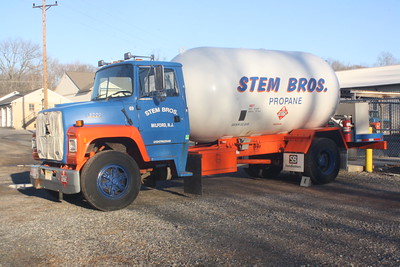
When propane burns, it reacts with oxygen in the air to produce carbon dioxide and water vapor. The chemical equation for this reaction is: C3H8 + 5O2 -> 3CO2 + 4H2O
This means that for every molecule of propane (C3H8) that burns, three molecules of carbon dioxide (CO2) and four molecules of water vapor (H2O) are produced.
The carbon dioxide produced during the combustion of propane is a greenhouse gas, which means that it can contribute to global warming by trapping heat in the Earth’s atmosphere. However, propane is considered to be a relatively clean-burning fuel, as it produces fewer harmful emissions than some other fossil fuels such as coal or oil.
In addition to carbon dioxide and water vapor, the combustion of propane can also produce small amounts of other gases and particulates, such as nitrogen oxides (NOx) and carbon monoxide (CO). These emissions can have negative impacts on air quality and human health, so it is important to use propane appliances and equipment properly and maintain them regularly to minimize the release of these substances.
Does Burning Propane Create Carbon Monoxide?
Burning propane can produce carbon monoxide (CO). Carbon monoxide is a colorless, odorless gas that is toxic to humans and animals. It is produced when fuels such as propane are burned without enough oxygen present to complete the combustion process.
In a properly functioning propane appliance or equipment, the combustion process should be complete, and the propane should burn cleanly, producing carbon dioxide and water vapor as the primary byproducts. However, if the appliance or equipment is not functioning properly, or if the propane is not being burned in a well-ventilated area, the combustion process may be incomplete, leading to the production of carbon monoxide.
Exposure to high levels of carbon monoxide can be dangerous, as it can interfere with the body’s ability to transport oxygen to the cells. Symptoms of carbon monoxide poisoning include headache, dizziness, nausea, and difficulty breathing, and can be life-threatening if left untreated.
To prevent carbon monoxide poisoning, it is important to use propane appliances and equipment properly and to ensure that they are well-ventilated. It is also a good idea to install carbon monoxide detectors in your home or business to alert you to the presence of the gas.
Read related article: Propane Suffocation: At What Level the Gas is Dangerous?
Why Burning Propane Makes Water
Burning propane produces water vapor as a byproduct of the chemical reaction that occurs when propane is burned.
The production of water vapor during the combustion of propane is due to the chemical makeup of propane, which contains hydrogen atoms. When the hydrogen atoms in propane react with oxygen in the air during the combustion process, they form water vapor.
The amount of water vapor produced during the combustion of propane will depend on the amount of propane being burned and the conditions of the combustion process. In general, the more propane that is burned, the more water vapor will be produced.
It is important to note that the water vapor produced during the combustion of propane is not in a liquid form and will not create puddles or pools of water. Instead, it is a gaseous byproduct of the reaction that can be released into the air.
Is Propane Toxic When Burned?
Propane is generally not considered to be toxic when burned, as it produces relatively low levels of harmful emissions compared to some other fossil fuels, such as coal or oil. However, there are a few potential risks associated with burning propane that you should be aware of:
- Carbon monoxide: Burning propane can produce small amounts of carbon monoxide (CO), which is a toxic gas that can be harmful to humans and animals. Carbon monoxide is produced when fuels such as propane are burned without enough oxygen present to complete the combustion process.
- Nitrogen oxides: Propane combustion can also produce nitrogen oxides (NOx), which are gases that can contribute to air pollution and have negative impacts on human health.
- Particulates: Propane combustion can also produce particulates, which are small particles of solid or liquid matter that can be inhaled and can have negative impacts on human health.
To minimize these risks, it is important to use propane appliances and equipment properly and to ensure that they are well-ventilated. It is also a good idea to install carbon monoxide detectors in your home or business to alert you to the presence of the gas. By following these guidelines, you can help to ensure that burning propane is safe and does not pose a risk to your health.
Combustion of Propane Enthalpy
The enthalpy of combustion is the amount of heat released during a chemical reaction. In the case of propane, the enthalpy of combustion is the amount of heat released when propane reacts with oxygen in the air to produce carbon dioxide and water vapor.
The enthalpy of combustion for propane is generally around -547.6 kilojoules per mole (-131.9 kilocalories per mole). This means that for every mole of propane that burns, -547.6 kilojoules (-131.9 kilocalories) of heat are released.
The enthalpy of combustion for a chemical compound is a useful way to compare the energy content of different fuels. For example, propane has a higher enthalpy of combustion than natural gas, which means that it releases more heat when burned. This makes propane a more efficient fuel for certain applications, such as heating or cooking.
It is important to note that the enthalpy of combustion is a theoretical value, and the actual amount of heat released during the combustion of propane will depend on a number of factors, including the efficiency of the appliance or equipment being used, the quality of the fuel, and the ambient temperature.
Chemical and Physical Properties of the Propane Molecule
Here are some of the chemical and physical properties of the propane molecule:
- Chemical formula: C3H8
- Molecular weight: 44.097 g/mol
- Boiling point: -44 degrees Fahrenheit (-42 degrees Celsius) at normal atmospheric pressure
- Melting point: -301.5 degrees Fahrenheit (-185.6 degrees Celsius)
- Density: 0.504 g/cm3 (at 25 degrees Celsius and 1 atmosphere pressure)
- Solubility: Propane is not soluble in water, but is soluble in some organic solvents
- Flammability: Propane is a flammable gas and can ignite if it comes into contact with a flame or spark
- Odor: Propane has a distinctive, rotten-egg-like smell that is added to the gas as a safety measure to help detect leaks
These are just a few of the chemical and physical properties of propane. Propane is a versatile fuel that is used in a wide range of applications, including heating, cooking, and generating electricity. Its unique properties make it well-suited for these uses, and it is a popular choice as a fuel in many parts of the world.
Environmental Impact
Burning propane has a distinct impact on the environment, especially when compared to other fossil fuels. Propane is known for burning cleaner than many other fuels. When it burns, it primarily releases water vapor and carbon dioxide. This means it produces fewer harmful pollutants like sulfur dioxide and nitrogen oxides, which are common in the emissions from burning coal or oil.
When we compare propane to other fossil fuels, the differences become clearer. For instance, burning coal or oil releases a lot more harmful substances into the air, contributing significantly to air pollution and the greenhouse effect. Propane, while not completely free of environmental impact, contributes less to these issues.
However, it’s important to remember that propane is still a fossil fuel. While it is a cleaner option, its combustion does release carbon dioxide, a greenhouse gas. So, while propane is a better choice environmentally compared to many alternatives, it’s not as clean as renewable energy sources like solar or wind power. Its use still contributes to climate change, but to a lesser extent compared to heavier fossil fuels.
Safety Considerations
Proper ventilation is crucial when using propane, especially during combustion processes. In confined spaces, burning propane can significantly reduce the oxygen level while increasing the concentration of harmful gases. This can lead to dangerous situations, such as asphyxiation or the buildup of explosive gases. To prevent such risks, it’s essential to ensure that the area where propane is being burned is well-ventilated, allowing fresh air to circulate and disperse any potentially harmful gases.
Beyond ventilation, other safety measures are important to consider. It’s vital to regularly check propane equipment for leaks or damages, as even a small leak can lead to a significant hazard. The use of propane detectors can also provide an early warning of gas leaks. Additionally, understanding and respecting the ignition sources is essential, as propane is highly flammable. Keeping flammable materials away from propane combustion areas and educating everyone involved about the proper handling and storage of propane are key steps in preventing accidents.
While propane is a useful and common fuel, its use comes with responsibilities. Ensuring proper ventilation and adhering to safety protocols can effectively mitigate the risks associated with propane combustion.
To Finalize This
Now that we’ve answered the question when propane burns what is the product, now you know the by-products. You need to be aware of these products as they can be harmful and for you to be able to take safety precautions when using this gas in your home or business.

Mike is an experienced propane technician with over 15 years of professional experience in the field. He has dedicated his career to helping customers with their propane needs, from installation to maintenance and repair. Together with Jeremy, he co-founded this website to provide useful information and guidance to customers seeking reliable propane services.



